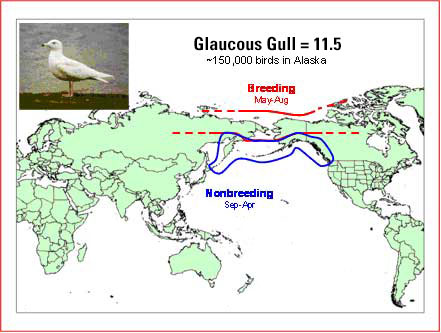Glaucous Gull, Larus hyperboreus
High-Priority Species ListSampling locations: The primary location is northwest Alaska. Samples will be taken from Barrow, St. Lawrence, and the Yukon-Kuskokwim Delta.
Sampling timeframe: During the breeding season in June to August.
Sample demographics: Adults will be sampled during summer.
Methods of capture: The sample goal of 200-300 can most easily be achieved through fecal sampling and/or live-trapping of birds at colonies or on-shore roost sites. Smaller numbers of samples could be obtained from lethal capture (~20-40 birds) if necessary.
Other targeted species: At the proposed primary sampling sites it will be possible to sample small to moderate numbers of Aleutian Terns and Common Eiders.
Contact: David Irons
Alaska Maritime NWR
Yukon Delta NWR
ASIS. 2006. Alaska seabird information Series, Glaucous-winged Gull. 2006. U.S. Fish and Wildlife Service, Migratory Bird Mgmt Rep., U.S. Fish and Wildlife Service, Anchorage, Alaska.
Bowman, T. D., R. A. Stehn, and K. T. Scribner. 2004. Glaucous Gull Predation of Goslings on the Yukon-Kuskokwim Delta, Alaska. Condor 106: 288-298.
Gilchrist, H. G. 2001. Glaucous Gull (Larus hyperboreus). In The Birds of North America, No. 573 (A. Poole and F. Gill, eds.). The Birds of North America, Inc., Philadelphia, PA.
Harrison, P. 1983. Seabirds, an identification guide. Houghton Mifflin, Boston.
Troy Ecological Research Associates. 2004. Movements of Glaucous Gull Trapped at the Barrow Landfill. Results from a 2003 Pilot Study. Troy Ecological Research Associates, Anchorage, Alaska.
U.S. Fish and Wildlife Service, 2006. Beringian Seabird Colony Catalog -- computer database and Colony Status Record archives. U.S. Fish and Wildlife Service, Migratory Bird Management, Anchorage, Alaska.

Ranking Score: 11.5
Asian H5N1 ranking criteria for Glaucous Gull, Larus hyperboreus.
Total of partial contact with Asia1 |
Contact with known "hot spot"2 |
Habitat used in Asia3 |
Pop. in Alaska4 |
Can samples be obtained? |
Score |
2.0 |
1.0 |
2.5 |
3.0 |
3.0 |
11.5 |
Estimate 20% winters in Asia |
No known use of AI-infected areas |
Estuaries and adjacent terrestrial areas; garbage disposal sites |
Approximately 100,000 |
Easily obtainable at garbage disposal sites; locations of breeding colonies known |

